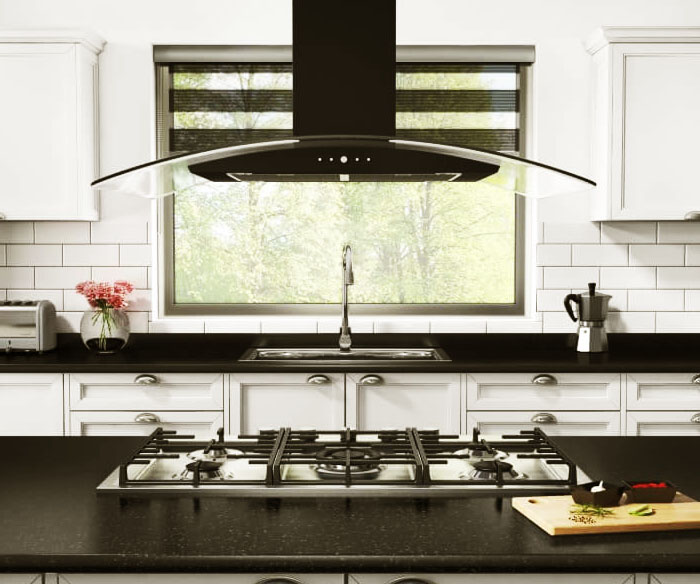
Working Principal of Kitchen Chimney :
A kitchen chimney is a contraption that vents smoke, moisture and grease-filled air. It reduces indoor air pollution, keeps your kitchen clean and prevents breathing problems.
Cooking releases a lot of solid and liquid microscopic particles called particulates or particulate matter (PM). They are approximately 1 to 10 micrometers in diameter, and consist of organic and inorganic substances like soot, smoke, water vapor, oil fumes, aromatic fumes and bits of food. Particulates are harmful for health and cause respiratory disorders. They need to be removed through chimneys, exhaust fans, windows and ventilators.
In modern Indian homes, chimneys are especially important due to the nature of the cuisine. Indian cooking entails plenty of frying and sautéing. A lot of our dishes have the typical ‘tadka’ style of preparation which produces clouds of fumes filled with oil, spices, organic matter and moisture.
If these pollutants are not immediately expelled, they stick to walls, ceilings, cabinets and appliances, and over time, impart a yellowish tinge to things, giving the kitchen a grimy look. Therefore, to prevent your house and everything in it from aging faster than they should, it is recommended that you install a good kitchen chimney.
Pro Tips : Quick Check
We recommend you to check following –
Table of Contents
How a kitchen chimney works ?
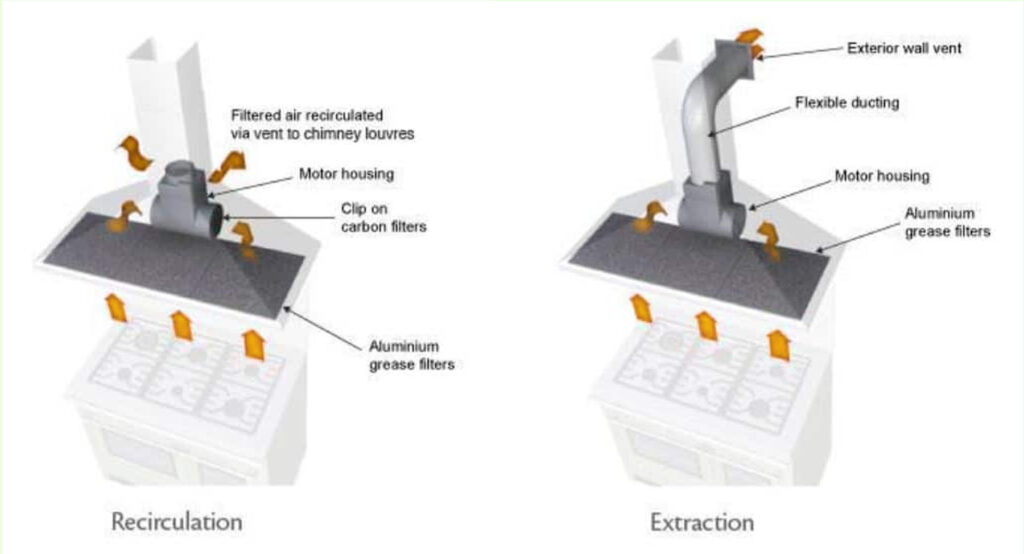
A chimney is essentially a ventilation device. It collects and routes out polluted air, leaving the indoor air refreshed and clean. A kitchen chimney is a necessary gadget for those who love cooking and entertaining guests at home with fresh home-cooked meals.
The mechanism behind a kitchen chimney is very simple. Smoke and oil droplets emitted during the cooking process are drawn into the chimney. The grease is trapped by the filters while the moisture and smoke are channeled out through the ducts and released into the outside environment.
A kitchen chimney can be ducted or ductless. The ways both these systems work have a few differences. A ducted chimney comprises of a hood, a motor, filters, hose pipes/PVC pipes and an elaborate ducting system. It requires proper plumbing for the ducts to be laid out and integrated into the masonry. It is generally placed directly above the stove to ensure maximum ventilation.
A ductless chimney is just like a ducted chimney except it has an additional carbon filter and lacks ducts. The polluted air first enters the primary filter which removes the oil droplets. Then the air moves through the carbon filter which eliminates bad odors, smoke and humid air. The recycled air is then released back into the house and not expelled like in a ducted chimney. This is the main difference between a ducted and a ductless chimney.
Ducted chimneys completely vent out the polluted indoor air while ductless chimneys purify it and route it back into the house. Ducted chimneys are more expensive than ductless varieties. But since their filters are washable, they have far less operating costs. They are also easy and cheap to maintain.
On the other, although ductless chimneys cost less during the initial installation, they have higher operating costs because carbon filters are not washable and need to be replaced every few months. Ducted chimneys are also more efficient as they have a higher suction power. They can remove heat and prevent condensation.
Ductless chimneys are not very good at keeping temperatures down. However, they are more flexible, and can easily be dismantled and relocated around the house.
Kitchen chimney vs exhaust fan which is better
Exhaust fans and kitchen chimneys both function to rid the kitchen of heat, smoke, and odors. One may be a better choice for your kitchen than the other, however, due to a few significant distinctions between the two. To compare exhaust fans to kitchen chimneys, consider the following data:
Benefits to health:
Kitchen chimneys are designed to keep airborne contaminants like smoke, carbon monoxide, and other dangerous gasses out of the air. This may lessen the likelihood of respiratory problems and enhance the quality of the air in your kitchen. There is not the same degree of air cleaning potential with exhaust fans.
Energy efficiency:
Because kitchen chimneys utilize a motor to draw out air and pollutants instead of pushing air out as exhaust fans do, they are often more energy-efficient than exhaust fans. This implies that installing a kitchen chimney might eventually lower your energy costs.
Cost:
Because of their sophisticated features and technology, kitchen chimneys for homes are more costly than exhaust fans. Nevertheless, they are a worthwhile investment for your kitchen since they provide improved performance and air quality.
Function:
An exhaust fan is a basic fan used in kitchens to expel heat, steam, and smoke when food is being prepared. On the other hand, the Faber Latest Kitchen chimney eliminates oil and grease particles from the air in addition to heat, steam, and smoke.
Noise:
While cooking, exhaust fans might be a distraction due to their tendency to be loud. On the other hand, since Faber Black contemporary kitchen chimneys are made to function silently, they are a better fit for open kitchen designs.
Suction power:
Exhaust fans are not as suction powerful as kitchen chimneys. This is so that a greater volume of air and contaminants from the kitchen may be drawn out of the chimney thanks to its strong motors and filters.
Upkeep:
Since all that needs to be done for an exhaust fan is to clean the cover and blades, maintenance is not too difficult. In contrast, the many filters in Faber’s New Kitchen chimneys need regular cleaning or replacement in order to guarantee optimal functioning.
Efficiency:
When it comes to eliminating smoke and smells from the kitchen, kitchen chimneys outperform exhaust fans. An exhaust fan just removes air from the kitchen; a kitchen chimney employs a strong suction motor to draw away smoke and other smells.
Aesthetics:
Since kitchen chimneys are available in a variety of styles and finishes to match your kitchen’s décor, they may enhance the visual attractiveness of your space. Exhaust fans, on the other hand, usually have a discreet or concealed installation and don’t enhance the kitchen’s general design.
Cooking habits:
Your cooking habits may also influence your decision between an exhaust fan and the finest kitchen chimney made by Faber. A kitchen chimney could be a better choice if you cook a lot of fatty meals since it can remove oil particles and fats from the air. An exhaust fan could be all you need if you cook less often and don’t make fatty or oily meals.
All things considered, a kitchen chimney is a more effective and efficient way to remove smoke and steam from your kitchen that also improves air quality and cleanliness, even if an exhaust fan is a straightforward and affordable option.
Type of filters
Now let us focus on the types of filters. Depending on the material and the kind of construction, chimney filters can be categorized into 3 types. First, there are the mesh filters or cassette filters. These are ideal for cooking styles that do not involve much oil. Then there are baffle filters which are great for Indian cooking. Lastly, there are charcoal filters which are used for removing pungent smells.
Let us now analyze each filter in a little more detail.
Mesh or cassette filter
This kind of filter is commonly used by all major kitchen chimney brands. It comprises of a thick mesh of aluminum or stainless steel. The mesh has multiple layers with numerous tiny pores for retaining and removing oil particles. The remaining smoke, carbon, water vapor and bad odors are ejected from the house through ducts.

Stainless steel cassette filters are costlier than their aluminum counterparts. They are heavy but easy to clean and maintain. Aluminum filters, on the contrary, are lightweight and easy to handle, but cleaning them can be a little tricky. Both stainless steel and aluminum mesh filters need to be washed once a week with dishwashing liquid and/or baking soda.
Please note that mesh filters are not suitable for Indian culinary preparations as they are not built to handle large amounts of oil-infused aerosols. The pores get clogged with oil which hampers the air flow and suction power of the chimney. Cassette filters are also maintenance-heavy and have recurring operating costs.
Pros
- It is simple to handle, comes in appropriate sizes, and is lightweight.
- has sophisticated cleaning capabilities.
- It is simple to remove the filter from the chimney.
- Safe for dishwashers
- Most affordable
Cons
- often needs to clear the blocked pores
- produces a lot of sound
Baffle filter
A baffle filter controls the flow of the air drawn up by it. It adopts a unique ‘cut and chop’ technique to separate the oil and food particles from the smoke. It is made up of multiple curved surfaces which retain oil and grease while the unwanted smoky air is expelled through the PVC ducts. The retention of oil by the filter does not hamper air suction.
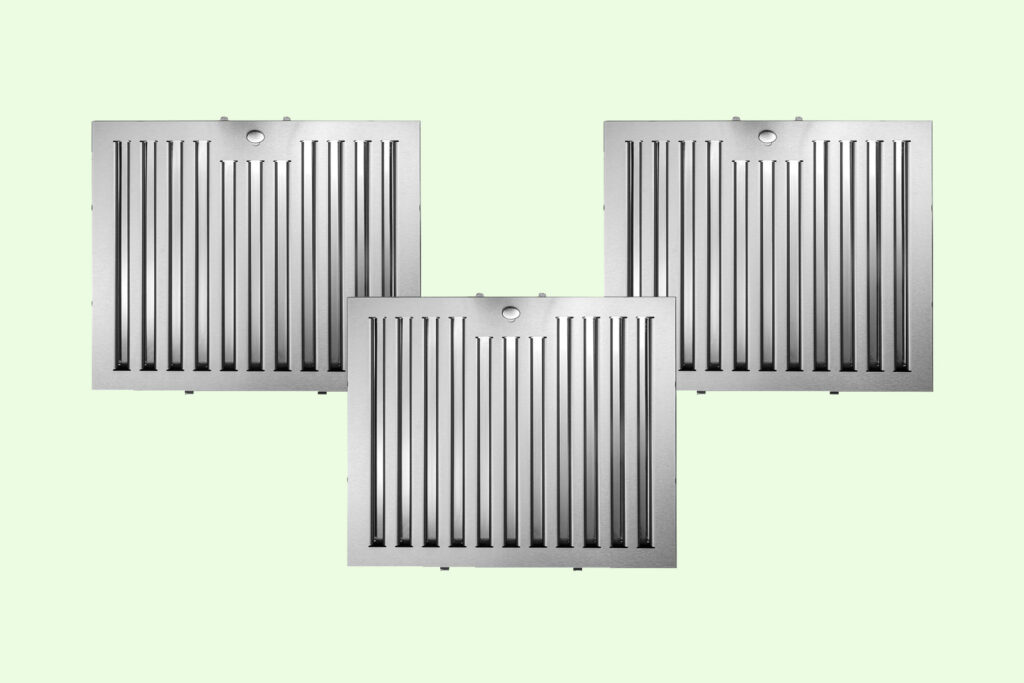
Hence, this kind of filter is best suited for Indian households. They are easy to clean and maintain. They are dishwasher-safe and can be washed using regular soap or liquid detergent. Baffle filters are generally made from stainless steel, although some traders also sell aluminum baffle filters.
The biggest plus-point of baffle filters is that they are extremely strong and durable. They have a sturdy construction designed to withstand the rigors of oil-rich cooking methods. They last longer than cassette filters and are maintenance-light.
Pros
- Oil and other heavy particles may be removed from the air with ease
- Durable and enduring
Reasonable cost
requiring minimal upkeep and cleaning.
Cons
can sometimes be louder
Greater than the average filter
Charcoal filter
Spice-laden cooking fumes can cause coughing, sneezing and irritation to the eyes, nose and throat. They must not be allowed to stagnate but immediately removed from the cooking area. This is where charcoal filters come in. They remove cooking smells like no other. Their surface area is artificially enhanced to attract pungent substances.

The pollutants stick to the surface of the carbon molecules by a process known as adsorption. They get taken out of the air flow, and are thus, prevented from circulating in the air. Charcoal filters are not washable. They have to be replaced once they are fully saturated. This means they come with an added running cost.
Pros
- As a secondary filter, it gets rid of any particles that the first filter misses.
- raises the standard of kitchen hygiene
Durable and enduring
Cons
Requires regular replacement
Not reversible
Types of chimneys
Depending on the way it is installed, a kitchen chimney can be classified into 4 main types: wall-mounted, island, straight-line and built-in.
Wall-mounted Chimneys:
Wall-mounted chimneys are the commonest kind of domestic chimneys. They are mounted on walls with the kitchen hood positioned directly over the cooktop.
Island Chimneys:
Island chimneys are secured to the ceiling and hang freely over the cooking platform. They are perfect for western kitchens with hobs where the stove or hot plate is integrated into the counter top.
Straight-Line Chimneys:
Straight-line chimneys are conventional kitchen chimneys. They are available in ducted and ductless variants.
Built-in Chimneys:
Built-in chimneys are integrated into the cabinetry above the cooktop. They remain hidden from view and blend in seamlessly with the decor of the kitchen.
Pro Tips : Insights about exhaust fan fundamentals will help you to choose whether it makes sense to upgrade a exhaust or buy a kitchen hood.
Know everything about HEPA filters in this detailed study. Read it now.
What to look for when buying a chimney?
There are Important Tips For Buying A Kitchen Chimney In India. If you are going to buy a Kitchen Chimney, you have to careful about it’s feathers, filter types and many more.
Consider Auto-Cleaning Features:
You have to consider at least Auto-Cleaning Features, it save your time and maintenance cost.
Size and Design:
As per your kitchen size, you have to check the design and size of the kitchen chimney you are buying.
What are the disadvantages of a kitchen chimney?
There are many advantages to having a kitchen with a chimney, including the removal of smoke, smells, and grease particles in the air from cooking. Nevertheless, there are several disadvantages to having a chimney in the kitchen as well:
Space:
Small or narrow kitchens may not be the best places for chimneys since they need space to be installed. It could take up less counter or storage space.
Cost:
If the kitchen does not already have the necessary fixtures, installing a chimney might be costly. Included in the pricing are the chimney itself, installation fees, and any potential need for extra ducting.
Maintenance:
In order to operate effectively, kitchen chimneys need regular cleaning and upkeep. The accumulation of grease and oil inside the chimney might result in diminished efficacy and airflow. Frequent cleaning may take a lot of time and may call for expert help.
Power consumption:
The fans and lights on electric chimneys are powered by electricity. Although many people would not see this to be a big deal, it can increase the amount of power used in the kitchen overall.
Noise:
When working, some kitchen chimneys might make noise that can be annoying when preparing food or serving meals.
Installation restrictions:
If you rent or live in an apartment, you may need permission from the management or landlord to build a chimney, and they may not allow changes to be made to the kitchen’s layout.
Despite these drawbacks, the capacity of kitchen chimneys to maintain a cleaner and more comfortable cooking atmosphere makes them important additions to many people’s kitchens. It’s important to assess the benefits and drawbacks of building a kitchen chimney in light of your unique requirements and kitchen configuration.

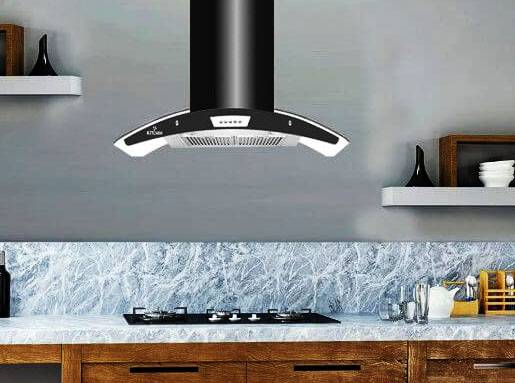
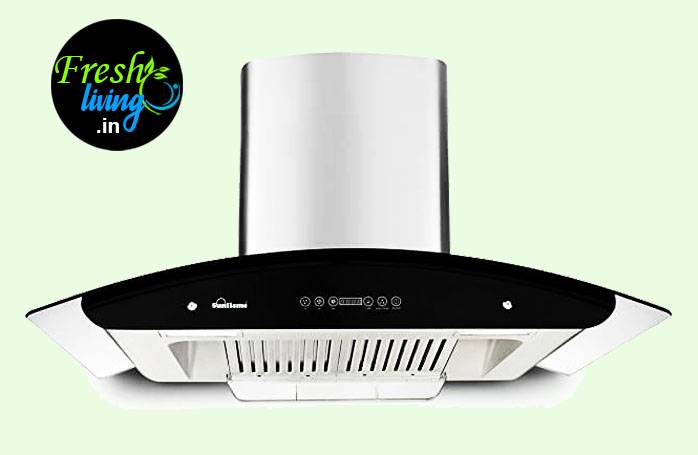
Pingback: Hindware Nevio 60 Auto Clean Chimney Review - Fresh Living